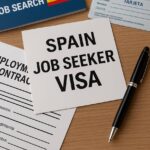Italy has long been a muse for artists, writers, digital nomads, and creative professionals from around the world. With its Renaissance heritage, vibrant cities, and Mediterranean lifestyle, it’s no surprise that freelancers are increasingly eyeing Italy as a place to live and work. But how do you legally move to Italy as a freelancer or artist?
In this comprehensive, educative guide, we break down how to apply for Italy’s self-employment visa (visto per lavoro autonomo), the requirements, steps, and tips to help you succeed in relocating to Italy in 2025 and beyond.
What is the Self-Employment Visa in Italy?
Italy’s self-employment visa allows non-EU citizens to live and work in Italy legally as freelancers, consultants, artists, or business owners. It is part of Italy’s annual Decreto Flussi (immigration quota decree), which sets a limit on how many self-employment permits are issued each year.
This visa is ideal for:
-
Freelancers (writers, designers, consultants)
-
Artists and performers
-
Digital nomads
-
Photographers, filmmakers, musicians
-
Independent contractors
Step-by-Step Guide to Moving to Italy as a Freelancer or Artist
Step 1: Check the Annual Decreto Flussi Quota
Before applying, ensure that Italy’s Decreto Flussi has allocated slots for self-employment in the current year.
-
Usually announced in spring or summer
-
Apply early because quotas are limited
-
Quotas vary based on type of self-employment and region
👉 Visit the Italian Ministry of Interior website or check with your local Italian consulate.
If you need an explanation on writing your CV, Cover Letter and Email Template or help applying speak to Happy Face
Step 2: Gather the Required Documents
Freelancers and artists must prove they have a real, ongoing activity that will be conducted in Italy. Documents include:
-
Valid passport
-
Proof of professional qualification (degree, diploma, portfolio, or artist resume)
-
Description of your freelance activity or artistic work
-
Contracts or letters of intent from clients or venues (if applicable)
-
Proof of income – at least €8,500/year (more is recommended)
-
Accommodation proof – lease or property ownership in Italy
-
Health insurance valid in Italy for at least 1 year
-
A certificate from the Chamber of Commerce in Italy stating there are no obstacles to your freelance work (Nulla Osta)
Step 3: Get a Nulla Osta (Authorization Certificate)
This is often the trickiest part.
-
You must apply for a Nulla Osta per lavoro autonomo from the Italian Chamber of Commerce, local labor office, or relevant authority in the city you plan to live in.
-
The office will review your documents to confirm your work aligns with Italian law and that your income is sufficient.
-
Once granted, you’ll receive a certificate to include in your visa application.
Tip: Consider hiring a local immigration lawyer or consultant to assist with this step, especially if you’re an artist with an irregular income.
Step 4: Apply for the Self-Employment Visa at the Italian Consulate
With the Nulla Osta and all your documents in hand, apply for your visa at the Italian consulate in your home country.
-
Make an appointment online
-
Submit your application form, passport, photos, and documents
-
Pay the visa fee (usually around €116)
-
Wait for approval (can take 2–3 months)
If you need an explanation on writing your CV, Cover Letter and Email Template or help applying speak to Happy Face
Step 5: Enter Italy and Apply for Your Residence Permit (Permesso di Soggiorno)
Once your visa is approved, travel to Italy and apply for your permesso di soggiorno per lavoro autonomo within 8 days of arrival.
-
Go to the local post office (Ufficio Postale) to get the application kit
-
Fill out the forms and pay the processing fee
-
Attend a fingerprinting appointment at the immigration office (Questura)
Your permit is usually valid for 1 to 2 years, renewable.
Can Artists and Creators Qualify Without Corporate Clients?
Yes. If you’re an independent artist—musician, painter, actor, or performer—you can submit:
-
A professional portfolio or press coverage
-
Invitations to exhibitions or performances
-
Gallery or venue contracts
-
Arts or performance grants
-
Proof of past income from creative work
You must still show that your work will continue in Italy and that you can support yourself financially.
Benefits of Moving to Italy as a Freelancer or Artist
-
Live in Italy legally while running your own creative or digital business
-
Access to Italian healthcare (after registering with the SSN)
-
Freedom to travel in the Schengen Area
-
Tax incentives: Italy offers tax breaks for new residents and freelancers
-
Pathway to permanent residency after 5 years
-
Apply for citizenship after 10 years of legal stay
If you need an explanation on writing your CV, Cover Letter and Email Template or help applying speak to Happy Face
Challenges and Tips
-
Navigating bureaucracy – Italian paperwork can be complex; patience is key.
-
Language barrier – Basic Italian helps greatly with forms and local offices.
-
Financial documentation – Be transparent and organized in showing earnings.
-
Professional help – Consider hiring a commercialista (tax advisor) or immigration lawyer.
Alternatives to the Self-Employment Visa
If the self-employment visa is too complex or not available under the current quota, consider:
-
Elective Residency Visa (for passive income earners or retirees)
-
Digital Nomad Visa (expected in 2025) – Italy is finalizing a new visa for remote workers with stable online income.
-
Student Visa – Study in Italy and then transition to freelance work.
-
Startup Visa – For entrepreneurs with innovative business ideas.
If you need an explanation on writing your CV, Cover Letter and Email Template or help applying speak to Happy Face
How to Transition to Permanent Residency and Citizenship
-
After 5 years of legal residence: apply for EU long-term residency.
-
After 10 years: apply for Italian citizenship (only 4 years if you’re of Italian descent or married to an Italian citizen).
-
Must show integration, language proficiency (A2 Italian), and financial stability.
If you need an explanation on writing your CV, Cover Letter and Email Template or help applying speak to Happy Face
If you’re looking for inspiration, a relaxed pace of life, rich history, and access to Europe—all while pursuing your creative or freelance career—then Italy is an excellent choice. Though the visa process takes patience and precision, the rewards are deeply fulfilling.
With the right preparation, documents, and mindset, your Italian dream as a freelancer or artist can become a beautiful reality.








